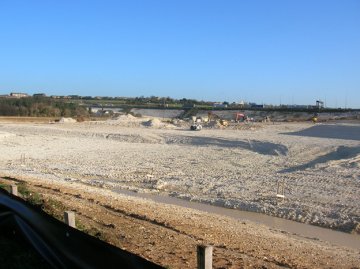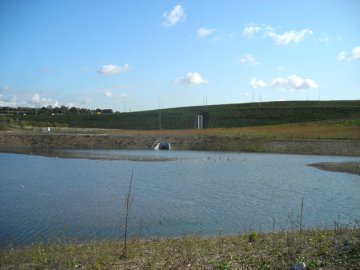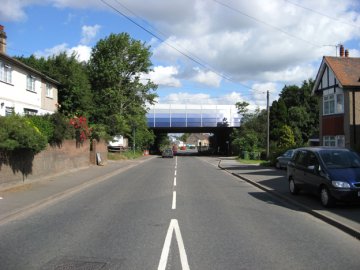A2/A282/M25 Highway Improvement SchemeWhole Project Award |
... |
75.7% |
The Project
|
Junction 1b of the M25 southwards to Junction 3 and the A2 between M25 Junction 2 and the Bean Junction to the east suffered from considerable congestion due to very high volumes of traffic. This improvement scheme was designed to:
- improve safety
- alleviate existing and anticipated future congestion
- assist the approach of traffic towards the Dartford Crossing without adversely affecting flows through Junction 2
- contribute towards an integrated and sustainable strategy by improving journey time reliability and providing better access to local regeneration areas.
The improvement scheme was given Notice to Proceed from the Secretary of State in July 2006 following a public inquiry in February 2004.
Costain, with Jacobs as designer, was appointed by the Highways Agency under a single ECI package including both the M25 J1b to J3 and the A2 widening from 3 to 4 lanes in each direction.
The operation of Junction 2 has been improved by the construction of extensive realigned and new slip roads with free-flow links. The project scope included significant earthworks remodelling and the construction of three major viaduct structures, including a 450-metre-long viaduct taking vehicles from the A2 directly onto the Dartford Crossing Approach. The works also included new lighting, signage and communications throughout.
The new earthworks for the junction incorporated ‘roll-over’ mounding for visual mitigation. New drainage arrangements completely replaced the existing failing system and included the creation of three new lagoons including a 1.3-hectare-lagoon set in a completely remodelled landscape.
Challenges
As one of the busiest junctions on the M25 it was vital to keep traffic moving. A quick moveable barrier system was used to allow rapid changes to traffic management arrangements within the working day to respond to changing traffic flows and thereby reduce the construction timescale.
|
The works were situated close to Dartford town and other smaller local communities that could have been adversely affected both during construction and in the long term. Extensive consultation was undertaken to understand local concerns and personal contact was maintained through the construction phase by a permanent site-based team of community liaison and environmental staff.
The overall length of all widening was about 6km, which was contained within the existing highway boundaries, except at the main junction. This was especially important as much of the A2 site is bounded by Darenth Woods, a Site of Special Scientific Interest (SSSI). Soft engineering solutions maximised the retained soft estate and the scheme included carrying out off-site woodland management within the SSSI to enhance the habitat for dormice.
Landscape and visual impact
The new structures at Junction 2 could not be screened within the existing landscape. The landscape and earthworks were therefore designed to provide significant amounts of ‘roll-over’ screen mounding with native planting that will in time soften the appearance of the junction.
This was a significant undertaking involving additional land take, but it provided the basis of a mitigation package giving immediate relief to the local community and to the wider environment both in terms of visual and noise impact.
A total of 125,000 native trees and shrubs were planted as part of the scheme and extensive additional strips of land were taken to increase the mass of potential woodland created around the junction. Mycorrhizal supplements were specified to aid root establishment and early growth of the trees.
The potential visual and environmental impacts of the extensive amounts of steelwork involved in the structures were analysed as part of the ECI design and assessment process and all structures were constructed using weathering steel. This not only avoided the extensive use of paints but also the long-term implications of maintenance in relation to environmental issues and health and safety.
Archaeology
Advanced archaeological excavations were undertaken in areas of high potential. Discoveries included possible evidence for Neanderthal occupation 100,000 years ago. This is early in the last Ice Age, a period in which Britain was thought to have been uninhabited.
The areas of interest were excavated and recorded leaving the site clear for construction. More recently, and following a full investigation, the finds have been written up and published as a stand-alone report for academic and public information.
Ecology
Dormouse habitat and its management was a critical part of the construction process, especially along the A2 where the widening works were adjacent to SSSI woodland and carried out under a Protected Species Licence.
Extensive survey work was followed by the development of a construction mitigation package which included management works in the adjacent woodland. Working in conjunction with the landowners and Natural England a phased programme of coppicing and control of weed tree species was undertaken over a period of three years to greatly enhance the habitat for dormice.
Common lizard and slow worm were translocated to specially prepared sites. Careful programming of the work ensured this could be undertaken without impacting on the overall progress of the project. The receptor site was further enhanced by the creation of additional grassland/scrub habitat as part of the landscaping of the major lagoon site north-west of Junction 2.
Before reprofiling the A2 cutting slopes, existing populations of wood ants were moved from the middle of embankments to the top, out of the construction zone. Site staff monitored the success of the operation and within a couple weeks the colonies had re-established.
Badger fencing was erected along the boundary of large parts of the scheme to stop badgers straying onto the A2 and M25.
|
|
Lagoon enhancements
The existing surface water drainage design on the M25 was out of date compared to modern standards of provision. This was a particular issue as part of the scheme was situated over a source protection zone relating to drinking water extraction points, as well as being in close proximity to the River Darent.
Drainage was redesigned to remove old soakaways within the source protection zone. A new treatment lagoon was constructed adjacent to the scheme and up-to-date pollution control measures were incorporated to prevent accidental spillages from reaching sensitive water resources.
The largest lagoon on the site was designed with shallow sides, a naturalistic shape and islands to offer a greater variety of habitats as well as providing a new landscape feature in keeping with its surroundings.
Additional land was taken around some lagoons allowing for large areas of new chalk grassland to be created. The reptile relocation site was integrated in this newly created habitat.
The smaller lagoons benefited from larger areas of new planting than would normally be the case and this was combined with a mosaic of open grassland areas providing a greater diversity of habitat. The abandoned original lagoon areas were enhanced to provide further new habitat areas.
Waste minimisation and carbon savings
A comprehensive waste recycling strategy was developed for the project, with an on-site waste minimisation campaign promoting the segregation and re-use of waste.
A high proportion of the aggregate used for road sub-base and surfacing was derived from recycled materials, principally spent railway ballast and recycled asphalt.
Site initiatives included a “Tools for Re-use” campaign helping to donate tools to Africa. Tree material from site clearance was saved along with other natural materials and re-used for hibernacula in the newly created landscape areas or converted to woodchip. Surplus woodchip material was donated to the adjacent riding stables.
27,500 tonnes of concrete and planings from the original road were treated on-site and re-used as fill material. None of this material was sent to landfill. As a result, the project appeared in the Environment Agency’s Spotlight on Business annual report as a case study on waste minimisation best practice.
The scheme also aimed to source most material from local suppliers, reducing CO2 emissions from transport by 75%. However, the most significant CO2 reduction came as a result of value engineering, whereby the volume of imported material was reduced by 90% from 1 million m3 to 100,000 m3.
The overall percentage of waste removed from site and sent to landfill was less than 30% and on-site separation of skip waste achieved a recycle rate of over 75%, saving £2,500.
Traffic noise improvements for the local community
The scheme has alleviated noise pollution along the worst affected stretch of the current road, between the A2 eastbound carriageway and the A282 northbound carriageway, through the installation of environmental barriers (earth mounds) along link roads between Junctions 1b and 2. The combination of these barriers and low-noise surfacing will reduce traffic noise in the design year (2022) by between 0.7 and 7.1 dB (A) for representative properties in this area.
Furthermore a 2-metre-high, 300-metre-long noise barrier in the vicinity of Hawley Manor on the north side of the A2 provides noise and visual screening to Grade II and II* listed buildings and a scheduled monument.
As the project progressed, additional lengths of environmental barrier were added after consultation with local residents groups.
Community and stakeholder relations
|
A local stakeholder group was established, enabling the scheme design and construction process to respond to local concerns. Stakeholder forums were held bimonthly on site, which included all local councils, environmental groups, the Highways Agency, Costain and the design team from Jacobs. As a result of this process, additional environmental barriers were added, the planting scheme was adapted and changed to include further off-site planting in consultation with local community groups, local environmental concerns were discussed and solutions found.
The local borough and parish councils raised concerns regarding the visual appearance and ease of access to the areas underneath Littledale viaduct. The site-based team in conjunction with the Highways Agency agreed a scheme using locally sourced stone, earth mounding, planting and high-quality fencing materials to effectively deal with antisocial behaviour and concerns about visual appearance.
The weathering steel option had significant advantages in terms of the environment and health and safety, but doubts remained within the local council about the visual qualities. A visit was arranged for the borough council representative to similar projects recently completed by Costain for the Highways Agency. This allayed any fears and weathering steel was adopted as the preferred option throughout the scheme.
The M25 crosses a local road at the heart of a small settlement, where for many years the local community had endured increasing noise and visual impact as traffic levels increased. The perception from the local community was that the proposed highway improvements would have a detrimental effect by moving traffic closer to the properties by a few metres.
Visual barriers were constructed on both sides of the M25 at Hawley to provide mitigation to properties on Hawley Road close to the scheme. Local residents were consulted on the design of the barrier on the M25 overbridge where it would be most visible. Following this, a blue-grey steel panel design was selected that blends into the skyline and greatly reduces the visual intrusion of the structure.
|
Throughout the project the opportunity was taken to help the local community. An outdoor patio area was provided for a local playgroup, tarmac and fencing was provided to the local school, recycled chippings were given to the local disabled riding school and materials provided to enhance access in Darenth Woods in support of a local project.







